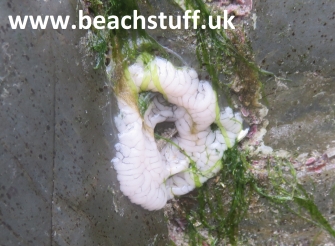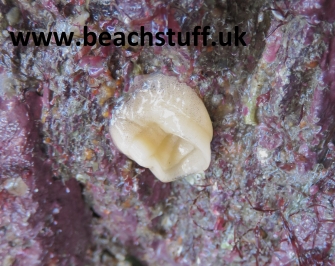

Sea slugs
(and sea slug-like things)
In the garden, we have snails and we have things that don't have shells but otherwise look like snails which we call slugs. In the sea, it is not so simple at all. Oh no. We have sea snails, with shells, and then we have sea slugs some of which were once sea snails but which have lost their shells, some of which are nudibranchs (surprisingly nothing to do with naked trees...) with no shells and sea slugs which have shells but we can't see them. Then there are some which are hares, or even cucumbers, and definitely not slugs at all.
To the casual observer, these all look pretty 'sluggy'.
So, for ease, I am going to lump them all together on this page as sea slugs even thought I am aware that this may make the purists cry.
I shall try to be clear about what each actually is but please forgive me if I get it wrong as trying to sort out my aplysiomorpha from my pleurobranchs gives me an ice-cream headache.
Some key terms that it is fine to forget.
Gastropod molluscs - slugs and snails living in salt water, fresh water and land. So this includes most of those that we know as sea slugs with the notable exception of sea cucumbers.
Nudibranchs - actually molluscs (sea snails) which lose their shells when they are adult. They breathe through an external gill on their backs.
Pleurobranchs - generally have an internal shell (or a vestige of one) and an external gill on their right side.
Pulmonates - like nudibranchs, these lose their mullusc shells as adults but, unlike the other sea slugs, they can breathe out of water.
Sea hares - have a bit of shell left in their bodies which we can't see and two ear-like things which makes them look a bit hare-like (although they are not to be confused with sea rabbits which are actually nudibranchs).
Sea cucumbers - Look more like slugs than most sea slugs, but not slugs. They are actually echinoderms - animals related to star fish and sea urchins.
Grey sea slug
Aeolidia papillosa
You would think that being called Grey means that it would have the decency to be grey but it can also commonly be brown or even a bit purple. This nudibranch eats anemones and 'saves' their stinging cells for use in its own cerata (fronds). Growing up to 12cm, it is probably the sea slug we are most likely to find in UK rockpools.

Here a grey sea slug is producing eggs, below are its strings of white eggs. It can produce nearly half a million at a time.


Sea Lemon
Archidoris pseudargus
A very common UK nudibranch also known as a sea lemon. However, most of us would have no idea that it is common because it is very difficult to see against the rocks, weeds and sponges amongst which it lives and, while we insist on calling it lemony, it can,in fact, be brown, green or pink. It very much likes to eat breadcrumb sponges.

I think that these may be the eggs of a sea lemon. If however, this comes up as a critical question in your marine biology masters paper, or some such, please double-check, as the world of slighty off-white sea slug eggs is a confusing one that I have some diffculty navigating.

Yellow-plumed sea slug
Berthella Plumula
Talking of yellow blobby things... This is a pleurobranch. I tried putting it on my hand to see if that made it look any more like a thing with form. It didn't help. They are generally about half the size of sea lemon, reaching a maximum length of 6cm.

When they sense danger, they can secrete sulphuric acid from their skin to poison predators. I may not have put this one on my hand if I had known this in advance.

Crested aeolis
Janolus cristatus
I love this nudibranch! Looks far too exotic for our waters. They can appear much browner than this one but are charcateristed by the electric blue pigment at the tips of their cerata (frondy bits). They can grow to about 7cm - this one was about 5cm long. They feed on bryozoans.

"Devon"
Goniodoris Nodosa
A small nudibranch which was first recorded in Devon. I mention this as I found this one pictured in Devon. Also, I have been unable to find a friendly name for it, so I thought we could call it Devon. "Devon" feeds on bryozoan and is small, not reaching 3cm in length.



Tenellia Foliata
I have never actually seen this nudibranch which may have something to do with the fact that it is tiny - less than a centimetre long at full stretch. However, with a not insignificant element of doubt, these are likely to be their eggs seen on the egg-skirt of a necklace shell.



Celtic Sea Slugs
Onchidella celtica
These are different to the other sea slugs on this page as they are air-breathing - pulmonates. They can thus be seen crawling around grazing algae on the surface of rocks when the tide is out. It can be difficult to tell fore from aft as their little antennae can get a little lost in their general wartiness.



Sea cucumbers
As I have not yet managed to photograph a sea cucumber on UK shores, here are a couple from Thailand.
The first is Holothuria atra, the black sea cucmber, is a whopper at around 20-30cm and can be seen just lying around on the sand in shallow waters.

While it can be difficult to see how sea cucumbers are related to starfish and urchins, they are like starfish without arms, and have an anus at one end and a mouth at the other so, in a sense, they are like an urchin lying on its side. The part of the urchin's skeleton which remains in a sea cucumber is a series of calcerous plates to which the mouth tentacles are attached.

The second is likely to be Holothuria Polii. It was buried in wet sand just by the water's edge. Squirted me sodden when I disturbed it.








